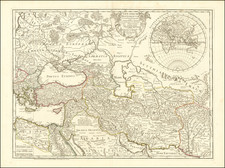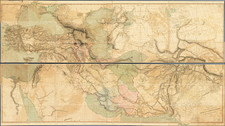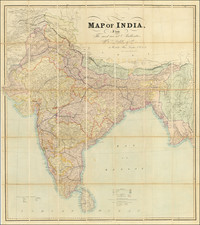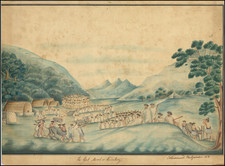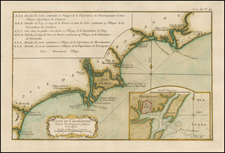The Medieval Trading Center of Dabhol
Scarce antique engraved view of Dabhol, published in Valentijn's Oud en Nieuw Oost-Indiën (1724–26).
Drawn from the official records of the VOC and other sources, Valentijn's view of Dabhol is on one of the earliest obtainable views the town.
Dabhol
Hardly a trace remains of the once-flourishing port of Dabhol on the north bank of the mouth of the Vashishti River in the Konkan region of India. The Russian traveler Athanasius Nikitin, who visited India (1468-1474) found Dabhol as a large town and extensive seaport. The horses from Mysore, Arabia, Khorasan and Nighostan were brought here for trade. This was the place which had links with all major ports from India to Ethiopia.
In the 15th and 16th centuries, Dabul was an important Muslim trade center, first under the Bahmani, later under the Badar sultans of Bijapur. As the port with most convenient access to the Bahmani sultanate's capital at Bidar, Dabul's fortunes ascended quickly with that dynasty. At its height, it was arguably the most important port between Chaul and Goa.
It was the prominence of Dabul as a Muslim trade center that led it to be bombarded, sacked and razed by a Portuguese expeditionary force (Battle of Dabul) under Francisco de Almeida in December, 1508, prior to the Battle of Diu, the the first of several times, in the course of the next few decades, that the Portuguese tried to destroy Dabul between 1508 and 1571.
Over time, regional commerce was redirected away from Dabul and towards the rising new port of Rajapur further south.
Dabul was conquered by Shivaji around 1660 and annexed to the new Maratha kingdom. The erection of the Anjanvel Fort Maratha fort of Anjnavel right across the river eclipsed whatever role remained for Dabul, and the once-great port city faded from existence.
Francois Valentijn and the Dutch East India Company Archives
Francois Valentijn (1666-1727) was a minister, naturalist and writer. He is best known for his Oud en Nieuw Oost-Indien ("Old and New East-India"), a book about the history of the Dutch East India Company and the countries of the Far East.
Valentijn was born in 1666 in Dordrecht, Holland, but spent significant time in the tropics, notably in Ambon, in the Maluku Archipelago. In total, Valentijn lived in the East Indies 16 years. Valentijn was first employed by the Dutch V.O.C. or East India Company (Vereenigde Oost-Indische Compagnie) at the age of 19, where he served as Minister to the East Indies. He returned to Holland for about ten years, before returning to the Indies in 1705 where he was to serve as Army Chaplain on an expedition in eastern Java. He again returned to Dordrecht where wrote his Oud en Nieuw Oost-Indien (1724-26) a massive work of five parts published in eight volumes and containing over one thousand illustrations and including some of the most accurate maps of the Indies of the time. He died in The Hague, Netherlands, in 1727.
Valentijn probably had access to the V.O.C.'s archive of maps and geographic secrets which they had always guarded jealously. Johannes Van Keulen II became Hydrographer to the V.O.C. in the same year Valentijn's book was published. It was in Van Keulens time that many of the VOC charts were published, one signal of the decline of Dutch dominance in Spice Trade. Valentijn was fortunate to have seen his work published, as the VOC (Dutch East India Company) strictly enforced a policy prohibiting former employees from publishing anything about the region or their colonial administration. And while, as Suárez notes, by the mid-18th Century the Dutch no longer feared sharing geographic secrets, the execution of this policy was still erratic and based on personal motives.
While Valentijn's maps and diagrams were prized possessions, his scholarship, judging by contemporary standards was not of the highest integrity. While current standards of referencing and plagiarism were not in effect during the 18th Century, Valentijn's borrowed liberally from other scientists' and writers. E.M Beekman referred to Valentijn as an "exasperating Dutch braggart," but nevertheless cites him as an important figure and, given his writing style, diction and penchant for story, one of the greatest Dutch prose writers of the time-going so far as to suggest comparison between one of the various stories in his work and a Chaucerian tale.
Valentijn was born in 1666 in Dordrecht, Holland, but spent significant time in the tropics, notably in Ambon, in the Maluku Archipelago. In total, Valentijn lived in the East Indies 16 years. Valentijn was first employed by the Dutch V.O.C. or East India Company (Vereenigde Oost-Indische Compagnie), at the age of 19, where he served as Minister to the East Indies. He returned to Holland for about ten years, before returning to the Indies in 1705, where he was to serve as Army Chaplain on an expedition in eastern Java. He again returned to Dordrecht where he wrote his Oud en Nieuw Oost-Indien (1724-26), a massive work of five parts published in eight volumes and containing over one thousand illustrations and including some of the most accurate maps of the Indies of the time. He died in The Hague, Netherlands, in 1727.
Valentijn likely had access to the V.O.C.'s archive of maps and geographic secrets which they had always guarded jealously. Johannes Van Keulen II became Hydrographer to the V.O.C. in the same year Valentijn's book was published. It was in Van Keulens time that many of the VOC charts were published, one signal of the decline of Dutch dominance in Spice Trade. Valentijn was fortunate to have seen his work published, as the VOC (Dutch East India Company) strictly enforced a policy prohibiting former employees from publishing anything about the region or their colonial administration. And while, as Suárez notes, by the mid-18th Century the Dutch no longer feared sharing geographic secrets, the execution of this policy was still erratic and based on personal motives.
While Valentijn's maps and diagrams were prized possessions, his scholarship, judging by contemporary standards, was not of the highest integrity. While current standards of referencing and plagiarism were not in effect during the 18th Century, Valentijn's borrowed liberally from other scientists' and writers. E.M Beekman referred to Valentijn as an "exasperating Dutch braggart," but nevertheless cites him as an important figure and given his writing style, diction and penchant for story, one of the greatest Dutch prose writers of the time-going so far as to suggest comparison between one of the various stories in his work and a Chaucerian tale.










